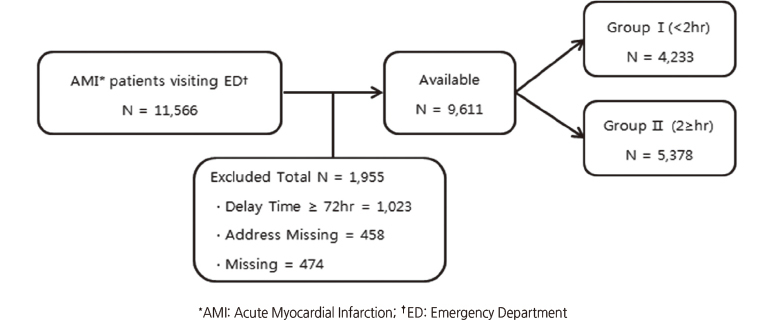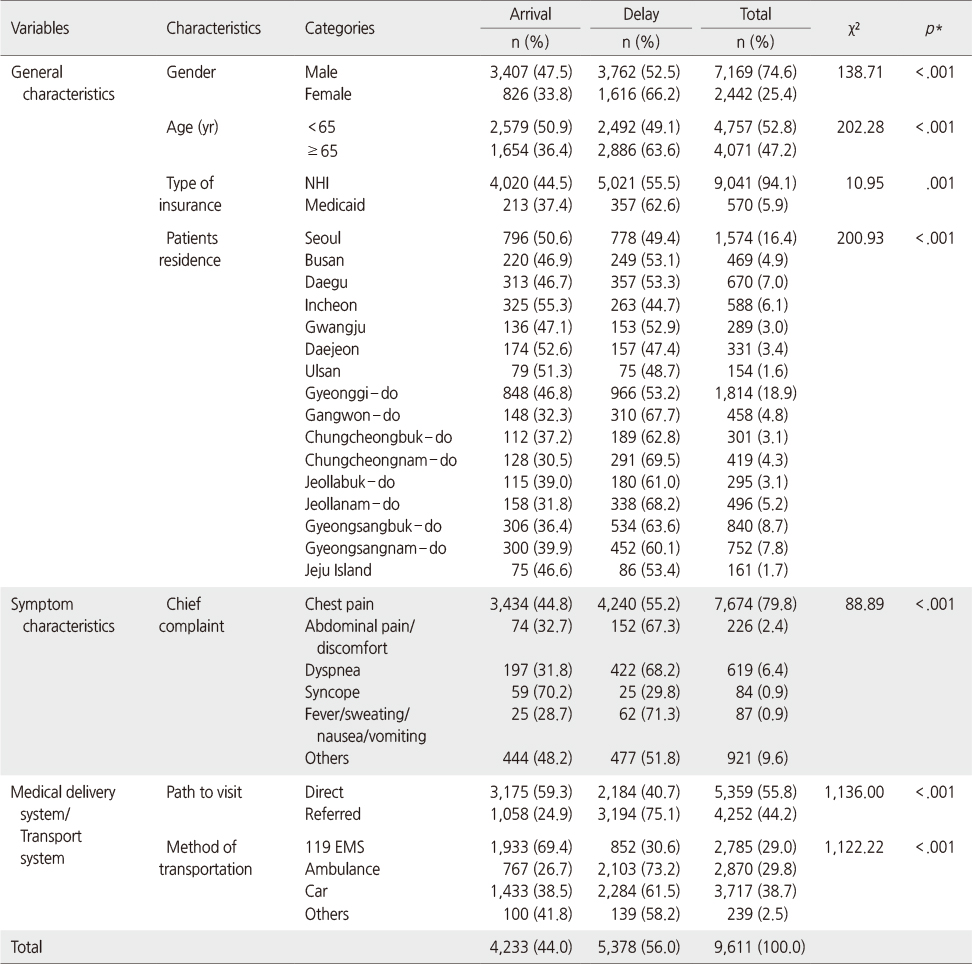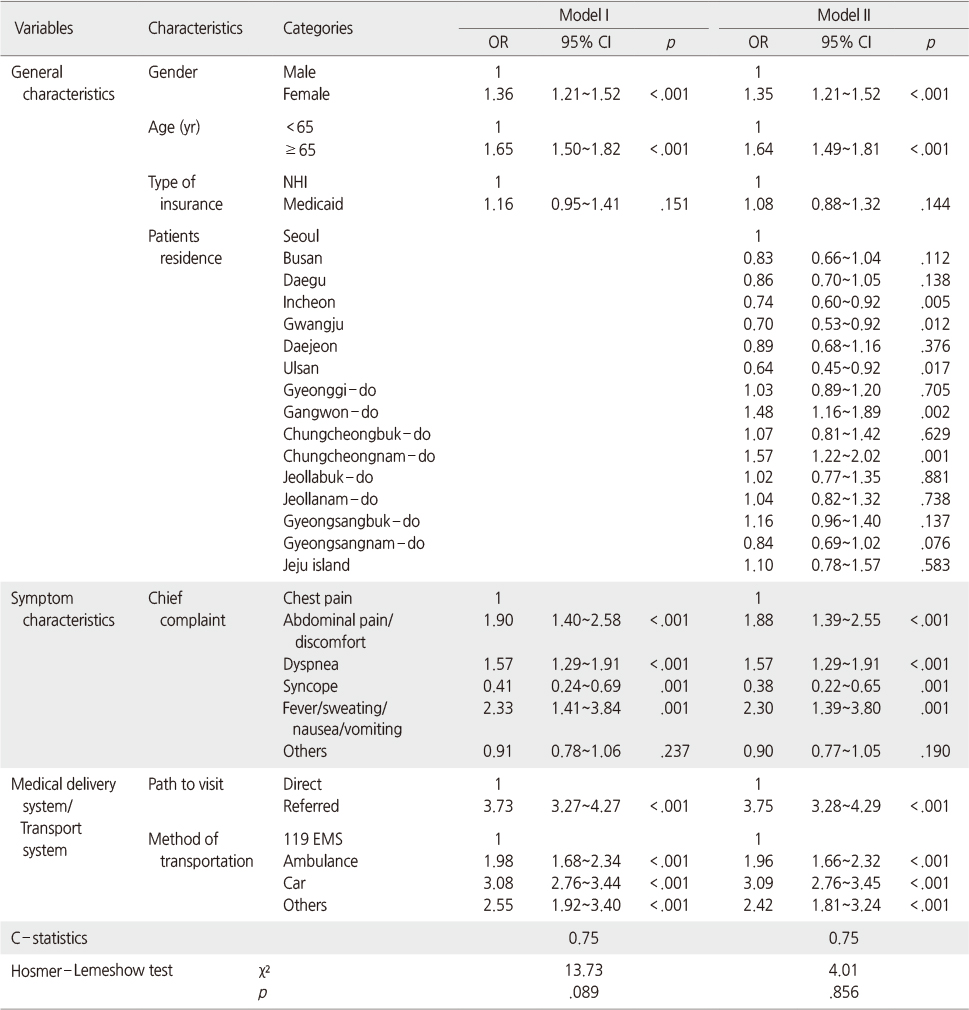Articles
- Page Path
- HOME > J Korean Acad Nurs > Volume 46(6); 2016 > Article
-
Original Article
- Hospital Arrival Rate within Golden Time and Factors Influencing Prehospital Delays among Patients with Acute Myocardial Infarction
- Hye Mi Ahn, Hyeongsu Kim, Kun Sei Lee, Jung Hyun Lee, Hyo Seon Jeong, Soung Hoon Chang, Kyeong Ryong Lee, Sung Hea Kim, Eun Young Shin
-
Journal of Korean Academy of Nursing 2016;46(6):804-812.
DOI: https://doi.org/10.4040/jkan.2016.46.6.804
Published online: December 30, 2016
1Department of Preventive Medicine, School of Medicine, Konkuk University, Seoul, Korea.
2Department of Emergency Medicine, School of Medicine, Konkuk University, Seoul, Korea.
3Department of Internal Medicine, School of Medicine, Konkuk University, Seoul, Korea.
4Department of Public Health Administration, Hanyang Women's University, Seoul, Korea.
- Address reprint requests to: Kim, Hyeongsu. Department of Preventive Medicine, School of Medicine, Konkuk University, 120 Neungdong-ro, Gwangjin-gu, Seoul 05029, Korea. Tel: +82-2-2030-7942, Fax: +82-2-2049-6192, mubul@kku.ac.kr
© 2016 Korean Society of Nursing Science
This is an Open Access article distributed under the terms of the Creative Commons Attribution NoDerivs License. (http://creativecommons.org/licenses/by-nd/4.0/) If the original work is properly cited and retained without any modification or reproduction, it can be used and re-distributed in any format and medium.
Abstract
-
Purpose
- This research was done to identify the hospital arrival rate and factors related to prehospital delay in arriving at an emergency medical center within the golden time after symptom onset in patients with acute myocardial infarction (AMI).
-
Methods
- Data used in the research was from the National Emergency Department Information System of the National Emergency Medical Center which reported that in 2014, 9,611 patients went to emergency medical centers for acute myocardial infarction. Prehospital time is the time from onset to arrival at an emergency medical center and is analyzed by subdividing arrival and delay based on golden time of 2 hour.
-
Results
- After onset of acute myocardial infarction, arrival rate to emergency medical centers within the golden time was 44.0%(4,233), and factors related to prehospital delay were gender, age, region of residence, symptoms, path to hospital visit, and method of transportation.
-
Conclusion
- Results of this study show that in 2014 more than half of AMI patients arrive at emergency medical centers after the golden time for proper treatment of AMI. In order to reduce prehospital delay, new policy that reflects factors influencing prehospital delay should be developed. Especially, public campaigns and education to provide information on AMI initial symptoms and to enhance utilizing EMS to get to the emergency medical center driectly should be implemented for patients and/or caregivers.
- 1. Statistics Korea. 2013 annual report on the cause of death statistics [Internet]. Daejeon, Author. 2014;cited 2016 January 20. Available from:http://kosis.kr/statisticsList/statisticsList_01List.jsp?vwcd=MT_ZTITLE&parentId=A
- 2. Goldstein P, Wiel E. Management of prehospital thrombolytic therapy in ST-segment elevation acute coronary syndrome (<12 hours). Minerva Anestesiol. 2005;71(6):297–302.PubMed
- 3. Solomon SD, Zelenkofske S, McMurray JJ, Finn PV, Velazquez E, Ertl G, et al. Sudden death in patients with myocardial infarction and left ventricular dysfunction, heart failure, or both. N Engl J Med. 2005;352(25):2581–2588. ArticlePubMed
- 4. Cannon CP, Gibson CM, Lambrew CT, Shoultz DA, Levy D, French WJ, et al. Relationship of symptom-onset-to-balloon time and door-to-balloon time with mortality in patients undergoing angioplasty for acute myocardial infarction. JAMA. 2000;283(22):2941–2947. ArticlePubMed
- 5. Zijlstra F, Patel A, Jones M, Grines CL, Ellis S, Garcia E, et al. Clinical characteristics and outcome of patients with early (<2 h), intermediate (2-4 h) and late (>4 h) presentation treated by primary coronary angioplasty or thrombolytic therapy for acute myocardial infarction. Eur Heart J. 2002;23(7):550–557. ArticlePubMed
- 6. Boersma E, Maas AC, Deckers JW, Simoons ML. Early thrombolytic treatment in acute myocardial infarction: Reappraisal of the golden hour. Lancet. 1996;348(9030):771–775. ArticlePubMed
- 7. Levine GN, Bates ER, Blankenship JC, Bailey SR, Bittl JA, Cercek B, et al. 2015 ACC/AHA/SCAI Focused update on primary percutaneous coronary intervention for patients with ST-elevation myocardial infarction: An update of the 2011 ACCF/AHA/SCAI guideline for percutaneous coronary intervention and the 2013 ACCF/AHA guideline for the management of ST-elevation myocardial infarction: A report of the American college of cardiology/American heart association task force on clinical practice guidelines and the society for cardiovascular angiography and interventions. Circulation. 2016;133(11):1135–1147. PubMed
- 8. Goldberg RJ, Steg PG, Sadiq I, Granger CB, Jackson EA, Budaj A, et al. Extent of, and factors associated with, delay to hospital presentation in patients with acute coronary disease (the GRACE registry). Am J Cardiol. 2002;89(7):791–796. ArticlePubMed
- 9. McKinley S, Dracup K, Moser DK, Ball C, Yamasaki K, Kim CJ, et al. International comparison of factors associated with delay in presentation for AMI treatment. Eur J Cardiovasc Nurs. 2004;3(3):225–230. ArticlePubMedPDF
- 10. Health Insurance Review & Assessment Service. 2013 evaluation result of acute myocardial infarction [Internet]. Seoul, Author. 2013;cited 2016 February 16. Available from:http://www.mohw.go.kr/front_new/al/sal0301vw.jsp?PAR_MENU_ID=04&MENU_ID=0403&CONT_SEQ=294566
- 11. Choi HK. Time delay and factors in patient with acute myocardial infarction. Annu Bull Seoul Health Coll. 1998;18:67–81.
- 12. An K. Pre-hospital delay in treatment after acute myocardial infarction. J Korean Acad Nurs. 2001;31(7):1141–1150.ArticlePDF
- 13. Lee JS, Lee J, Kang J, Ko Y, Park JM, Park TH, et al. Prognostic modeling for an efficacy and a safety of thrombolysis in acute ischemic stroke. J Korean Neurol Assoc. 2012;30(2):100–109.
- 14. Song YB, Hahn JY, Gwon HC, Kim JH, Lee SH, Jeong MH. The impact of initial treatment delay using primary angioplasty on mortality among patients with acute myocardial infarction: From the Korea acute myocardial infarction registry. J Korean Med Sci. 2008;23(3):357–364. ArticlePubMedPMC
- 15. Lee JH, Jeong MH, Rhee JA, Choi JS, Park IH, Chai LS, et al. Factors influencing delay in symptom-to-door time in patients with acute ST-segment elevation myocardial infarction. Korean J Med. 2014;87(4):429–438. Article
- 16. Yeungnam University Health Care Service Support Center. Development of 2nd phase comprehensive management plan for cardioand cerebrovascular diseases (2011-2015). Seoul: Korea Health Promotion Foundation; 2010.Report No.: Policy 10-22.
- 17. Cheskes S, Turner L, Foggett R, Huiskamp M, Popov D, Thomson S, et al. Paramedic contact to balloon in less than 90 minutes: A successful strategy for st-segment elevation myocardial infarction bypass to primary percutaneous coronary intervention in a canadian emergency medical system. Prehosp Emerg Care. 2011;15(4):490–498. ArticlePubMed
- 18. Korea Health Industry Development Institute. Emergency medical basic planning and emergency medical operating systems evaluation. Seoul: Author; 2005.
- 19. Goldberg RJ, Yarzebski J, Lessard D, Gore JM. Decade-long trends and factors associated with time to hospital presentation in patients with acute myocardial infarction: The Worcester Heart Attack study. Arch Intern Med. 2000;160(21):3217–3223. ArticlePubMed
- 20. De Luca G, Suryapranata H, Ottervanger JP, Antman EM. Time delay to treatment and mortality in primary angioplasty for acute myocardial infarction: Every minute of delay counts. Circulation. 2004;109(10):1223–1225. ArticlePubMed
- 21. Banks AD, Dracup K. Factors associated with prolonged prehospital delay of African Americans with acute myocardial infarction. Am J Crit Care. 2006;15(2):149–157.ArticlePubMedPDF
- 22. Carney R, Fitzsimons D, Dempster M. Why people experiencing acute myocardial infarction delay seeking medical assistance. Eur J Cardiovasc Nurs. 2002;1(4):237–242. ArticlePubMed
- 23. Ministry for Health WaFA, Gachon University of Medicine and Science. Analysing of emergency medical service and the support strategies for remote-isolated area. . Seoul: National Emergency Medical Center; 2007.
- 24. Horne R, James D, Petrie K, Weinman J, Vincent R. Patients' interpretation of symptoms as a cause of delay in reaching hospital during acute myocardial infarction. Heart. 2000;83(4):388–393. ArticlePubMedPMC
- 25. Ministry of Health & Welfare. Korea Health Promotion Foundation. Health plan 2020, 2016~2020. Sejong: Author; 2015.
- 26. Lee JH, Sohn JD, Kim SW, Chung TN, Park YS, Park IC. The effect of symptom recognition on pre-hospital delay in patients with acute coronary syndrome. J Korean Soc Emerg Med. 2010;21(1):9–18.
- 27. Lee MW, Kim KS, Kim YJ, Cho IS, Kim TY, Rhee JE, et al. Delays in reperfusion of patients with ST elevation myocardial infarction: According to mode of transportation and arrival time. J Korean Soc Emerg Med. 2010;21(1):1–8.
- 28. Johansson I, Strömberg A, Swahn E. Factors related to delay times in patients with suspected acute myocardial infarction. Heart Lung. 2004;33(5):291–300. ArticlePubMed
- 29. Meischke H, Ho MT, Eisenberg MS, Schaeffer SM, Larsen MP. Reasons patients with chest pain delay or do not call 911. Ann Emerg Med. 1995;25(2):193–197. ArticlePubMed
- 30. McKinley S, Moser DK, Dracup K. Treatment-seeking behavior for acute myocardial infarction symptoms in North America and Australia. Heart Lung. 2000;29(4):237–247. ArticlePubMed
- 31. Gim D. Analysis of changes to equality in health and medical service utilization by income levels. J Ins Soc Sci. 2012;23(3):105–125.Article
REFERENCES
Figure & Data
REFERENCES
Citations

- The effect of public reporting of acute myocardial infarction on the choice of hospital
Mira Kim, Kyungshin Lee, Kyunghee Chae, Chai-Young Jung, Sangmin Lee, Hude Quan, Sukil Kim, Ricardas Radisauskas
PLOS One.2025; 20(5): e0323780. CrossRef - Acute myocardial infarction treatment delay in South Asia: a systematic review and meta-analysis
Deepthi Ramamurthy, Meely Panda, Manjula Rangappa, Suthanthira Kannan, Rashmi Kundapur, Swetha Rajeshwari, Padmavathi Subbiah, Pradeep Aggarwal, Sumit Aggarwal
Future Cardiology.2025; : 1. CrossRef - Regional Health Disparities between Mortality Rates in Three Leading Causes of Death : A Comparative Study of Spatial Dependence in Local Death Rate between Cancer, Heart Disease, and Pneumonia
Hee-Jung Jun, SeungYeoup Kang
Journal of Korea Planning Association.2023; 58(2): 38. CrossRef - Determination of the optimal location of samples on quartz tuning fork-based biosensors: a computational study
Amir Hossein Atabaki, Abbas Montazeri, Hashem Rafii-Tabar, Pezhman Sasanpour
Biomedical Physics & Engineering Express.2021; 7(6): 065024. CrossRef - Blood Pressure Awareness and Knowledge of Cardio-Cerebrovascular Diseases in South Korean Women with Hypertension
Yeo Won Jeong
Healthcare.2021; 9(3): 360. CrossRef - Predictors of anticipated coping behavior at myocardial infarction symptom onset among a nationwide sample of Korean adults
Kyong Sil Park
Epidemiology and Health.2021; 43: e2021006. CrossRef - The Effect of Residence in Underserved Emergency Medical Services Areas on Awareness of Myocardial Infarction Symptoms in Korea
Mirae Jo, Heeyoung Oh, Suk-Yong Jang
Journal of Health Informatics and Statistics.2021; 46(1): 8. CrossRef - Study on Cases of Priority Traffic Signal System for Emergency Vehicles: Based on a City’s Pilot Operation Cases in Chungcheongbukdo Province
Jin-Hyeon Kim, Hyo-Ju Lee
Fire Science and Engineering.2020; 34(1): 121. CrossRef - Effect of percutaneous coronary intervention team prenotification based on real time electrocardiogram transmission in interhospital transfer of ST elevation myocardial infarction patients: pilot trial of Preparing Revascularization Effort before Patients
Man Soo Jung, Yong Won Kim, Sanghun Lee, Jun Seok Seo, Jeong Hun Lee, Seung Chul Lee, Han Ho Do
Clinical and Experimental Emergency Medicine.2020; 7(2): 114. CrossRef

Figure 1
Comparison of Arrival Rate with Variables of Study Population
*p-value for differences by χ2 test; NHI=National Health Insurance; EMS=Emergency Medical Service.
Logistic Regression for Delay related Variables
NHI=National Health Insurance; EMS=Emergency Medical Service.
*
NHI=National Health Insurance; EMS=Emergency Medical Service.
 KSNS
KSNS
 E-SUBMISSION
E-SUBMISSION



 Cite
Cite

